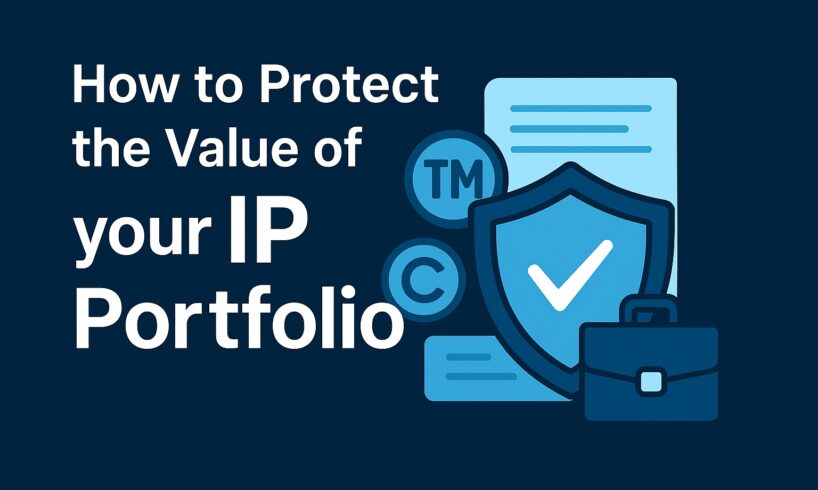
IP deals rarely fail because someone forgot to file a trademark. They fail because of small operational gaps that compound over time. The ten mistakes below directly erode valuation, licensing leverage, and your ability to survive diligence.
Why IP Monetization Fails In Practice
Deals rarely collapse because someone forgot to file a trademark application. They fall apart because of small operational mistakes that only surface when a buyer, lender, or licensee starts pulling on threads.
In one licensing deal I watched, U.S. counsel discovered that the only “use” evidence for a key trademark consisted of internal invoices to affiliates, not real sales to unrelated customers. The registration looked perfect: timely renewals, no oppositions, a clean certificate. Under diligence, the mismatch between the registration and the real business became obvious and the deal nearly collapsed.
When companies talk about “IP strategy,” they usually mean filing more applications or expanding into more countries. That is not monetization.
Monetization is what happens when trademarks and other rights support real commercial outcomes: higher licensing fees, better exit valuations, leverage in negotiations, cleaner franchising structures, and more predictable enforcement. The companies that succeed treat their global trademark portfolios as business infrastructure, not as legal paperwork.
Earlier this month, I moderated the global IP strategic planning and monetization panel at the Technoeconomics Symposium, which reinforced what I see daily in my IP practice: IP monetization succeeds or fails on execution, not on theory.
What follows are ten recurring problems from trademark and copyright work, especially in cross-border matters. If you are trying to turn registrations into revenue and build a global trademark portfolio that actually holds its value, these are the issues that quietly erode it long before anyone notices.
Ten IP Monetization Mistakes To Fix Now
1. Treating U.S. “Use in Commerce” as an Afterthought
In many countries, you can register a mark with little or no real world use and keep it alive with minimal follow up. The United States does not work that way.
Here, enforceability and long term validity hinge on genuine commercial use in connection with the goods and services listed in the registration. For anyone trying to monetize a global trademark portfolio that includes the United States, this creates two immediate problems.
First, foreign owners routinely miss intent to use deadlines, submit specimens that do not show real use, or register marks with no plan to put them into the market.
Second, monetization efforts end up built on sand. Once a buyer or licensee suspects that the underlying use is not there, they either walk away or demand protections that survive closing and choke economics.
Most other countries do not have U.S. style use requirements. That reality enables defensive registrations, but it also encourages bad faith behavior such as squatting. A monetization plan that ignores these structural differences between the United States and the rest of the world is asking for trouble.
The Fix: Build genuine commercial use into your U.S. plan from the start, and make sure you can show real sales to unrelated customers with robust specimens that match the goods and services in your registrations.
2. Choosing Brand Names Without Checking Registrability
Branding exercises often start in the wrong room. A creative team falls in love with a name based on how it looks and sounds, with no serious check on whether it can be protected and enforced where it actually matters.
From a monetization perspective, that is backwards. If a name is descriptive, already crowded with similar marks, or problematic in key markets, you are investing in something you will never fully own.
A portfolio built for monetization requires at minimum:
A clear view on distinctiveness
Targeted knockout searches
Deeper clearance where the stakes justify it
Thoughtful consideration of linguistic and cultural translation
A compelling brand that cannot be protected is not an asset. It is a liability that eventually forces an expensive rebrand or a messy coexistence that weakens value across markets.
The Fix: Involve trademark counsel early in the naming process, run knockout searches and deeper clearance where the business case justifies it, and pressure test short-listed names for distinctiveness and linguistic or cultural problems in your key markets before you commit serious spend.
3. Assuming the Madrid System Will Solve Everything
The Madrid Protocol is an efficient administrative tool. Used well, it simplifies filings and reduces upfront costs. Used indiscriminately, it creates long term problems in countries where the underlying home registration, classification system, or examination practice do not align with local realities.
For businesses focused on monetization, that matters. Gaps, vulnerabilities, or odd limitations introduced through a Madrid based strategy will show up in diligence. Sophisticated counterparties know where Madrid origin portfolios tend to be weak and they adjust valuation accordingly.
Madrid should be one tool in the box, not the default for every country on the list. A serious global trademark portfolio strategy decides where Madrid makes sense and where direct national filings are worth the extra effort.
The Fix: Use Madrid selectively. Map where it fits your enforcement, classification, and cost goals, and where direct national filings will produce stronger, more reliable rights. Periodically review older Madrid based designations to identify and shore up fragile coverage in critical markets.
4. Misaligned Goods and Services Descriptions
Goods and services descriptions that work in one country often fail in another. This is more than a formality.
In the United States, the USPTO expects a level of detail that goes beyond what many comparable offices require. It also charges higher fees when applicants bypass the USPTO’s preapproved language in the Trademark ID Manual. China and other countries favor their own rigid lists, which can make cross-border alignment difficult or impossible.
From a monetization standpoint, sloppy descriptions lead to narrow or uneven protection across countries, greater difficulty enforcing against close imitators, and avoidable costs and delays at the application stage.
The portfolios that command a premium price are those where descriptions have been drafted with an eye on both local practice and cross-border consistency, and where the wording actually matches what the business sells.
The Fix: Treat goods and services descriptions as strategic drafting, not clerical work. Align wording with actual business lines, use local preferred language where needed, and aim for as much cross-border consistency as practice allows so that your protection envelope is clear and defensible across markets.
5. Maintenance Failures Signal Weak Controls
Maintenance failures are a quiet destroyer of IP value. A lapsed registration is not just a problem in that jurisdiction. It is also a data point about how the company manages its rights.
Buyers and licensees ask a simple question: if the owner missed a basic renewal or proof of use deadline, where else is the portfolio vulnerable?
In the United States, the Section 8 declaration of use between years five and six catches many foreign owners off guard, precisely because most other countries do not require equivalent mid term proof of use filings. Similar pitfalls exist in Mexico, the Philippines, and other markets.
In one transaction, a buyer discovered repeated lapses and last-minute grace period renewals in key markets and immediately treated this as evidence of weak internal controls. Diligence dragged, protections tightened, and the overall deal economics shifted in the buyer’s favor.
A serious monetization plan treats maintenance as a core control function, not an afterthought. A portfolio with clean, timely renewals and proof of use filings looks immediately more credible in any deal.
The Fix: Centralize renewal and proof of use tracking, calendar all critical dates, and assign clear ownership for maintenance in each key market, with particular attention to mid term filings such as U.S. Section 8 and similar requirements in a handful of other jurisdictions.
6. Weak Portfolio Governance and Lack of a Central Control Tower
Many portfolios grow opportunistically. A distributor requests protection in Brazil. A marketing campaign targets Germany. A franchise opportunity opens in the Philippines. Each decision makes sense in isolation.
Over time, the result is a patchwork: the parent company owns rights in the United States, a German subsidiary holds the EU marks, a distributor controls rights in Brazil, and nobody is quite sure who owns Japan. Core brands are protected in some markets but not others. Some low revenue jurisdictions have full protection while high threat markets remain exposed. Renewal practices are fragmented and no one has a single, reliable view of upcoming deadlines.
When local counsel are added to this without central coordination or updated information, the operational risk multiplies. If they do not have current contact details, corporate structure charts, or clear internal points of contact, they cannot reliably manage deadlines, office actions, or enforcement. That is when preventable lapses, missed filings, and slow infringement responses start to pile up.
From the perspective of a sophisticated buyer or licensee, this kind of portfolio signals weak governance. They have to reverse engineer your strategy, and often there is no strategy to find.
The portfolios that monetize well are built around clear commercial priorities and managed through a central hub, a trademark control tower that coordinates local counsel, tracks all deadlines, and maintains a master register of who owns what, where, and why, aligned with the corporate structure.
The Fix: Establish a central trademark control tower to coordinate local counsel, track deadlines, maintain a current ownership and filing register, and align new filings and renewals with a clear, documented brand and market strategy.
7. Leaving Chain of Title and Security Interests Messy
Monetization depends on clean ownership. In real life, companies merge, spin off lines of business, reorganize subsidiaries, and shift assets for tax or operational reasons. If trademark assignments do not keep pace, or if transfers happen informally with no follow through on recordation, the result is a broken or unclear chain of title.
In financing and M&A deals, lenders and investors often take security interests over the IP, essentially a lien on your trademarks if you default. If those security interests are not properly recorded in the relevant registers, or if they conflict with the ownership records, the result is confusion and extra risk for everyone at the table.
For a buyer or licensee, this is friction they do not need. They may require remedial assignments, insist on price adjustments, or simply walk away. I have seen transactions delayed for months while sellers chased former owners and former executives across jurisdictions to sign corrective documents that should have been handled years earlier.
Maintaining a current, documented chain of title and properly recorded security interests across the portfolio is one of the lowest cost steps an owner can take to protect future deal value.
The Fix: Systematically review past assignments, reorganizations, and security interests, and ensure that they are properly documented and recorded in the relevant IP registers in each key jurisdiction so that ownership and security positions match what you are presenting in the deal room.
8. Weak Enforcement History Undercuts Deal Value
Some owners assume registrations speak for themselves and that formal enforcement can wait until things become serious. Monetization does not work that way.
When counterparties evaluate a portfolio, they look for signs that the owner has actually used the marks in the marketplace and taken reasonable steps to police confusingly similar uses.
A history of ignoring obvious infringements or tolerating widespread unlicensed use tells buyers and licensees that the claimed exclusivity may be weaker than it appears. In one deal, diligence revealed dozens of long standing copycat uses that the brand owner had documented internally but never addressed. The buyer did not walk away, but its view of the mark’s strength changed overnight, and so did the terms it was willing to offer.
You do not need to sue everyone. You do need a defensible enforcement posture you can explain and document for key markets in your global trademark portfolio.
The Fix: Maintain a documented, defensible enforcement posture against key infringers in core markets, so that you can show a clear willingness to defend your exclusivity and maintain the premium you are asking counterparties to pay.
9. Believing Registration Automatically Equals Monetization
Owners sometimes assume that once rights are registered in a long list of countries, monetization will follow.
In reality, monetization is an active discipline. It combines business development, legal strategy, enforcement, relationship management, and internal coordination across brands, legal, and finance.
Registration is not the finish line. It is the starting point for the commercial work that actually turns a global trademark portfolio into a revenue generating asset.
The Fix: Tie new filings, renewals, and enforcement decisions to a written monetization plan that identifies which brands and markets drive revenue, pricing power, and realistic licensing opportunities, and be willing to prune registrations that do not support that plan.
10. Ignoring the Copyright and Trade Secret Layer
Most trademark licensing does not move a word mark in isolation. It moves a bundle of rights and assets.
Typical examples include copyrighted materials such as packaging art, logos, websites, marketing content, and software, along with trade secrets and know how such as recipes, formulations, operational manuals, and franchise procedures.
If the trademark ownership looks clean but the underlying creative or technical assets are not properly documented, assigned, or protected, the deal value still drops. This is especially common in cross-border franchise and licensing models. The logo was designed by an agency that never assigned copyright. The packaging artwork is owned by a contractor in Vietnam. The operations manual exists only in the founder’s head. Suddenly, “licensing the brand” is not so simple.
The mistake is assuming that clean trademark title means the entire brand system is clear to license. A serious monetization strategy reviews the surrounding copyright and trade secret layer and makes sure the rights that actually power the brand are as clear as the registrations.
The Fix: Audit and formalize ownership for all supporting assets, including copyrights, logos, packaging, software, and operational know how, using signed assignment and confidentiality agreements where appropriate, so that the package you are licensing matches the value you claim.
Next Steps: Bringing It All Together
The Technoeconomics discussion confirmed what I see daily in practice. IP monetization succeeds or fails on execution, not on abstract strategy decks. The failures are rarely dramatic. They show up in small, compounding operational gaps: missed deadlines, unclear ownership, weak enforcement, poorly chosen marks, registrations that do not match the underlying business activity, and portfolios that nobody truly owns inside the organization.
The upside is that these issues are fixable. Companies that address them early build global trademark portfolios that withstand diligence, support stronger licensing terms, and hold real, defensible value across borders.
If you see three or more of these issues in your own portfolio, fix them now, before you walk into your next serious licensing, financing, or transaction discussion. Cleaning up a portfolio on your own timeline costs a fraction of what it costs under deal pressure.
Do not wait for a deal to break. Use the simple three step plan in the FAQ below to stabilize your portfolio now, while you can still do it on your own terms.
Action Step: Use the “What should companies prioritize first if their portfolio is already messy?” FAQ answer below to create a three-step cleanup plan. Then pick one area, chain of title, maintenance deadlines, or core brand protection, and actually fix it this quarter.
FAQ on IP Monetization and Global Trademark Portfolios
How does a global trademark portfolio actually create monetization value?
It creates value by supporting concrete business objectives, such as justifying higher license fees, achieving better exit valuations, and strengthening negotiating leverage against competitors. The portfolio becomes monetizable when the rights are clear, enforceable, aligned with your real business footprint, and backed by real-world use and consistent enforcement.
Why are U.S. “use in commerce” rules so important for a global strategy?
The United States is typically both a key revenue market and a major focus during diligence. If U.S. registrations are vulnerable due to weak proof of use, sophisticated buyers and licensees will often assume similar weaknesses exist in the rest of the global portfolio. Strong, well-maintained U.S. rights often anchor confidence in the rest of the portfolio.
Is the Madrid Protocol still worth using if it can create problems?
Yes, if you are selective. Madrid is efficient for administrative filings, but you still need to assess where it fits your enforcement, classification, and local-practice goals. A mixed approach—using Madrid for some countries and direct national filings for others—often yields stronger, more reliable rights. See The Madrid System for Trademarks: Powerful, But Not Always the Right Tool.
How does IP cost management relate to portfolio value? Is it wise to cut costs aggressively?
Yes, if done intelligently. Audit your portfolio, identify non-core marks in non-material markets, and consider abandoning those so budget can be redirected to your core assets. A small set of brands in your top markets usually drives most revenue. Protecting those aggressively while trimming low-value filings strengthens both the portfolio and the monetization story. Indiscriminate cost cutting that lets important registrations lapse or skips essential clearance work does the opposite.
How important is the recordation of security interests for monetization?
t is very important in any financing or M&A context. Unrecorded security interests (liens) or conflicts with the chain of title create significant risk for lenders and investors and can slow diligence, increase legal costs, or in some cases derail a deal entirely.
What is the biggest mistake companies make regarding valuation of their trademarks?
The biggest mistake is treating valuation as a static number instead of a fact-supported narrative. True value is based on evidence of real-world use, a track record of enforcement, and the defensible price premium you can charge over a competitor.
What should companies prioritize first if their portfolio is already messy?
Start with three areas: (1) clean up ownership by fixing breaks in the chain of title; (2) stabilize maintenance by mapping all proof-of-use and renewal deadlines; and (3) prioritize core assets by protecting the brands and countries that actually drive revenue, then rationalize the rest over time.
When is the right time to involve outside counsel in IP monetization planning?
Outside IP counsel adds the most value before you start a major expansion, a new licensing or franchising program, or a significant financing or sale. Waiting until you are in a live deal means you will pay significantly more to fix problems under time pressure instead of structuring the portfolio on your own schedule.





